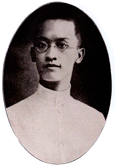Hu Hanmin

Hu Hanmin (traditional Chinese: 胡漢民; simplified Chinese: 胡汉民; pinyin: Hú Hànmín; born in Panyu, Guangdong, China, December 9, 1879 – Guangdong, China, May 12, 1936) was one of the early conservative right factional leaders in the Kuomintang (KMT) during revolutionary China.
Biography
Hu was of Hakka ancestry from Ji'an, Jiangxi. His father had moved to Panyu, Guangdong to take up an official post.[1] He was qualified as juren at 21 years of age. He studied in Japan starting in 1902, and joined Tongmenghui as an editor of Minbao in 1905. From 1907 to 1910, he participated in several armed revolutions. Shortly after Xinhai Revolution in 1911, he was appointed the governor of Guangdong and chief secretary of the Provisional Government. He participated in the Second Revolution in 1913, and followed Sun Yat-sen to Japan after the failure of that revolution. There they established the Chinese Revolutionary Party. Hu lived in Guangdong between 1917 and 1921 and worked for Sun Yat-sen, as the minister of transportation first and principal consultant later.
Hu was elected to be a central executive committee member in the first conference of Kuomintang in January, 1924. In September, he acted as vice generalissimo, when Sun Yat-sen left Guangzhou to Shaoguan.[2] Sun died in Beijing in March, 1925, and Hu was one of the three most powerful figures in Kuomintang. The other two were Wang Jingwei and Liao Zhongkai. Liao was assassinated in August of the same year, and Hu was suspected and arrested. After the Ninghan split in 1927, Hu supported Chiang Kai-shek and was head of the Legislative Yuan in Nanjing.
Later on February 28, 1931, he was placed under house arrest by Chiang because of disputes over the new provisional constitution. Internal party pressure forced Chiang to release him. After that, Hu became a powerful leader in South China, holding three political principles of resistance: resistance against Japanese invasion and massacre, resistance against militarist Communists, and finally resistance against the self-proclaimed leader, Chiang Kai-shek. The anti-Chiang factions in the KMT converged on Guangzhou to set up a rival government. They demanded Chiang's resignation from his dual posts of president and premier. Civil war was averted by the Japanese invasion of Manchuria. Hu continued to rule southern China, the heartland of the KMT, with the help of Chen Jitang and the New Guangxi clique. There he attempted to create a model government free of corruption and cronyism to discredit Chiang's Nanjing regime.
Hu was an advocate of action against Japanese aggression, criticizing Chiang for "his spineless failure to adopt a strong policy towards the foreign power which has torn and ravaged our homeland!"[3]
Hu visited Europe and stopped his political attack on Chiang Kai-shek in June, 1935. In the first session of the fifth conference of Kuomintang in December 1935, he was absently elected as the Chair of Central Committee of Common Affairs. Hu returned to China in January, 1936, and lived in Guangzhou until he died of cerebral hemorrhage on May 12, 1936.
His death sparked a crisis. Chiang wanted to replace Hu with loyal followers in southern China and end the autonomy the south enjoyed under Hu. As a result, Chen and the New Guangxi clique conspired to remove Chiang from office. In the so-called "Liangguang Incident", Chen was forced to resign as governor of Guangdong after Chiang bribed many of Chen's officers to defect and the conspiracy collapsed.
Hu's political philosophy was that one's individual rights are a function of one's membership in a nation.
References
- ↑ "胡汉民 为何能是孙中山的得力助手".
- ↑ "CHINA: Swath to Success". TIME. July 23, 1934. Retrieved May 22, 2011.
- ↑ "CHINA: Swath to Success". TIME. July 23, 1934. Retrieved May 22, 2011.
| Wikimedia Commons has media related to Hu Hanmin. |
| Party political offices | ||
|---|---|---|
| Preceded by Sun Yat-sen |
Premier of the Kuomintang 1925–1931 |
Succeeded by title abolished |
| Preceded by none |
Chairman of Central Executive Committee of Kuomintang (Nanjing) 1927–1931 |
Succeeded by Wang Jingwei |
| Political offices | ||
| Preceded by none |
President of the Legislative Yuan 1928-1931 |
Succeeded by Shao Yuanchong |
